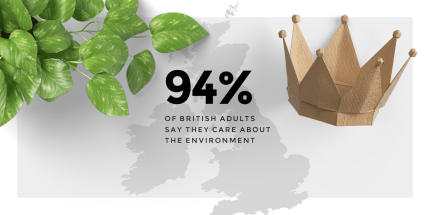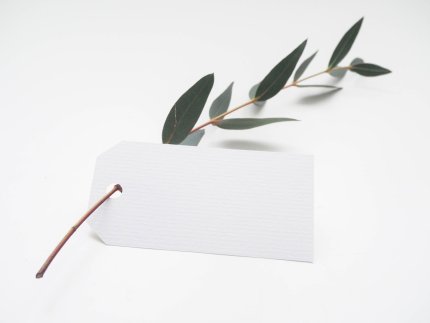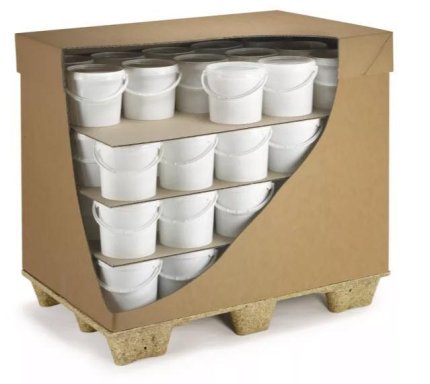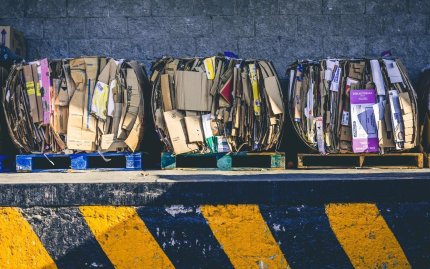When it comes to what we can recycle, cardboard, cans and certain plastics certainly come to mind. But what about other common household items that don’t get the recycling recognition they deserve? Not to mention, there’s a major step that can be taken before your items even go near the recycling bin – reusing them to create something new or to fit a different purpose.
There is a plethora of items that are either reusable or recyclable (or both!), that just end up in the bin when they still have so much more use left in them, like excess packaging from online orders, old clothes or even furniture.
To highlight just how simple it is to make eco-responsible choices in your everyday life, we challenged artist Roy Tyson to create a diorama using surprisingly sustainable items. What he created was a miniature masterpiece depicting an allotment scene.
Using an egg carton as the foundation of the allotment, Tyson turned bottle caps, pen lids and Crayons into plant beds and support systems. Eco-bubble wrap provides the perfect protection for the miniature vegetables and screws make the ideal trellis for the tiny pumpkin patch. Other materials include staples and wool. With a little creativity, it’s clear to see that you can reuse items way beyond their original function to extend their lifecycle and create something new. Not only will you have something unique, but you’ll be helping to reduce your impact on the environment and tackle climate change at the same time.
Surprisingly sustainable items in your home
With a bit of creativity and effort, your old cardboard box can become a playhouse for your child, bottle lids can become a cool feature piece in your home and plastic bags can make the perfect lining for plant beds in the garden. Here are a few surprisingly sustainable items that can be reused before they go into the recycling bin:
Bubble wrap – At a loss for what to do with the bubble wrap that keeps your online orders safe? Well, it makes an excellent covering for your vegetables and the perfect insulation for windows in winter months to keep the cold out. Or you could simply save it for when you have to store precious items. Once you’re done with it, check to see if it is recyclable bubble wrap and, if so, make sure it goes in the recycling bin so it can be made into something new.
Clothing – It is estimated that each member of the British public throws away about 3.1kg of textiles every year and 1.7kg of that is landfilled1. That is an astronomical number when added up, so it’s time to get creative with garments that don’t suit your style anymore. Upcycle, repair, sell or donate any items that you no longer want, to prevent them from going to landfill.
Stationery – If you’re having a clear-out of unwanted stationery, like pens, pencils, paper, staples and paper clips, ask your local schools if they can make use of the items. Just make sure they are still in good working condition.
Carpet – The UK generates as much as 500,000 tonnes of carpet waste a year2. Reduce this waste by getting creative and making a new rug, a floor mat for your car or front door, or even a cat scratching mat to preserve the new carpet. If that doesn’t pique your interest, take a look to see if there is a local carpet recycling centre that you can take it to.
Sustainability in Britain
We know that recycling is important but knowing what can and can’t be recycled often comes with a little confusion. So much so, 79% of Brits revealed that they fail to recognise recycling signs on packaging, not knowing if they mean the item can be recycled or not3 . This lack of knowledge could be why recycling rates have plateaued since 2013, which is having a knock-on impact on the environment4.
However, nearly everything can be reused, and many items are surprisingly recyclable. One way to minimise your waste and improve how much you recycle is making conscious decisions at the point of purchase. While you can recycle more than you think, it’s important to buy good quality items that will last a long time, can be reused and eventually recycled at the end of their lifecycle.
In 2019, the UK generated 22.1 million tonnes of ‘waste from households’, which is the equivalent of 392 kg per person5. Taking the time to learn what your local council can and can’t recycle can significantly reduce the waste you produce. If you know that your local recycling centre doesn’t take a certain material, perhaps seek a different option that uses eco-friendly packaging that you can reuse or recycle when you’re finished with it.
Reuse before you recycle
Of the three R’s: reduce, reuse, recycle, it’s the latter that usually first comes to people’s minds. While recycling is a crucial step in the lifecycle of the items we use, the importance of reusing items for other purposes around the house needs more recognition. The rule of thumb is that if the item is in good condition, it can still be reused. As you can see in our diorama, it doesn’t just have to be in the house, think about how your garden, garage and even an allotment (if you have one) can benefit from repurposed goods.
Reusing items extends their lifecycle, reducing the amount of material that goes into landfills or recycling centres, meaning less energy is needed to break down items and re-manufacture them. Reusing items can involve repairing items, upcycling, selling them on or even donating them. Remember, just because you can’t reuse a jumper or an old phone, doesn’t mean someone else won’t be happy to put it to good use – one man’s trash truly is another man’s treasure.
This is something that many people are embracing by upcycling everything from clothes and furniture to cardboard boxes and bubble wrap. Upcycling involves taking something that would otherwise be waste and improving it to bring it back to life, so that you or someone else can enjoy it. One study by Loop stated that over 102 tonnes of bulky items were removed from the waste stream through repurposing and upcycling items6.
Not only does repurposing materials like bubble wrap rolls, cardboard boxes, lids, clothes and even stationery save you money by extending their lifespan, but it can also reduce your carbon footprint and turn them into something new that you love for years to come.
About the artist
Roy’s People is the pseudonym of artist Roy Tyson who specialises in creating witty and intriguing imagery using customised miniature figurines. Roy began photographing the miniature worlds that he creates on the streets of London in 2012, before progressing into miniature diorama installations and corporate commissions to bring a variety of brands’ visions to life.
[1] https://labfresh.eu[2] https://www.plasticexpert.co.uk[3] https://www.saveonenergy.com[4] https://assets.publishing.service.gov.uk[5] https://assets.publishing.service.gov.uk[6] https://www.recyclingwasteworld.co.uk





















